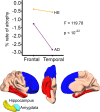One-year brain atrophy evident in healthy aging
- PMID: 19955375
- PMCID: PMC2827793
- DOI: 10.1523/JNEUROSCI.3252-09.2009
One-year brain atrophy evident in healthy aging
Abstract
An accurate description of changes in the brain in healthy aging is needed to understand the basis of age-related changes in cognitive function. Cross-sectional magnetic resonance imaging (MRI) studies suggest thinning of the cerebral cortex, volumetric reductions of most subcortical structures, and ventricular expansion. However, there is a paucity of detailed longitudinal studies to support the cross-sectional findings. In the present study, 142 healthy elderly participants (60-91 years of age) were followed with repeated MRI, and were compared with 122 patients with mild to moderate Alzheimer's disease (AD). Volume changes were measured across the entire cortex and in 48 regions of interest. Cortical reductions in the healthy elderly were extensive after only 1 year, especially evident in temporal and prefrontal cortices, where annual decline was approximately 0.5%. All subcortical and ventricular regions except caudate nucleus and the fourth ventricle changed significantly over 1 year. Some of the atrophy occurred in areas vulnerable to AD, while other changes were observed in areas less characteristic of the disease in early stages. This suggests that the changes are not primarily driven by degenerative processes associated with AD, although it is likely that preclinical changes associated with AD are superposed on changes due to normal aging in some subjects, especially in the temporal lobes. Finally, atrophy was found to accelerate with increasing age, and this was especially prominent in areas vulnerable to AD. Thus, it is possible that the accelerating atrophy with increasing age is due to preclinical AD.
Figures





References
-
- Allen JS, Bruss J, Brown CK, Damasio H. Normal neuroanatomical variation due to age: the major lobes and a parcellation of the temporal region. Neurobiol Aging. 2005;26:1245–1260. discussion 1279–1282. - PubMed
-
- Ashburner J, Andersson JL, Friston KJ. High-dimensional image registration using symmetric priors. Neuroimage. 1999;9:619–628. - PubMed
-
- Buckner RL, Snyder AZ, Shannon BJ, LaRossa G, Sachs R, Fotenos AF, Sheline YI, Klunk WE, Mathis CA, Morris JC, Mintun MA. Molecular, structural, and functional characterization of Alzheimer's disease: evidence for a relationship between default activity, amyloid, and memory. J Neurosci. 2005;25:7709–7717. - PMC - PubMed
-
- Burgmans S, van Boxtel MP, Smeets F, Vuurman EF, Gronenschild EH, Verhey FR, Uylings HB, Jolles J. Prefrontal cortex atrophy predicts dementia over a six-year period. Neurobiol Aging. 2009a;30:1413–1419. - PubMed
Publication types
MeSH terms
Grants and funding
LinkOut - more resources
Full Text Sources
Medical
